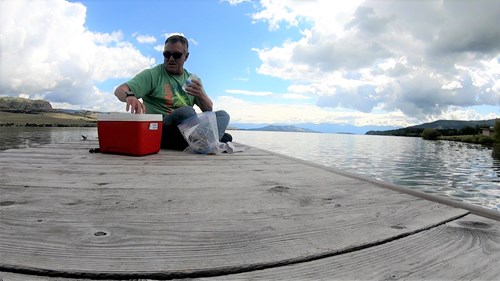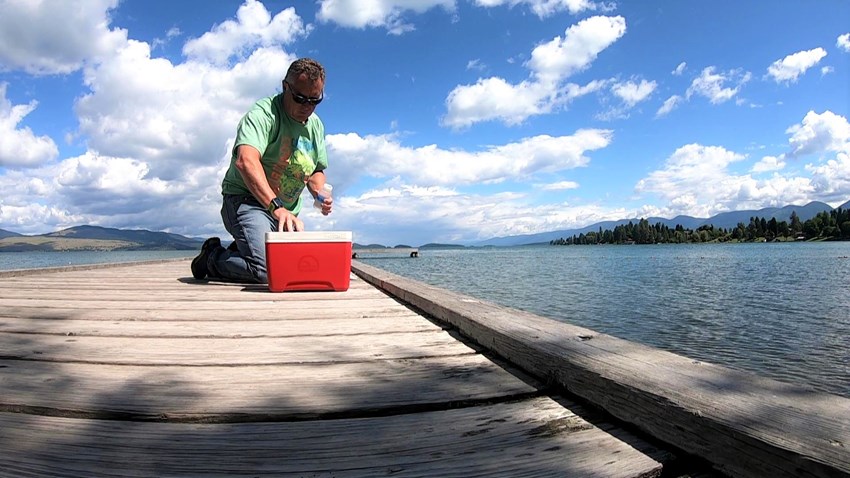Flathead Lake Water Quality Maintains High Marks as Swim Guide Citizen Science Project Continues Dramatic Growth
According to data from the 2019 Swim Guide Citizen Science Project, public swim areas at Flathead Lake have passed with a 100 percent success rate and were safe for swimming throughout the summer for the second consecutive year.
“The sampling was great this season,” said Mark Johnston, founder of the Flathead Lake Open Water (FLOW) Swimmers and a driving force behind the Swim Guide Citizen Science Project at Flathead Lake. “The recreational water quality of Flathead Lake remains exceptional.”
The Swim Guide Project is a collaborative effort between the Flathead Lake Biological Station (FLBS), the Confederated Salish and Kootenai Tribes, and the FLOW Swimmers United States Masters Swimming Club in Polson, along with funding and effort from numerous Adopt-a-Beach partners.
The Project is meant to be a community-driven water quality monitoring program, and was created to provide water quality information on the Swim Guide website and smartphone app (https://www.theswimguide.org/). The Swim Guide app and website aim to help users easily find which beaches are open for public swimming, and whether or not those beaches meet water quality standards.
The Swim Guide website states that a beach is marked red—or unsafe for swimming—either when the average of two consecutive single sample results are equal to or over 100 colony-forming units (cfu) of bacteria such as E. coli per 100 milliliters (mL) of water, or if a single sample exceeds 320 cfu per 100 mL of water.
Of the 110-plus tests conducted by the Flathead Lake Biological Station in 2019, the highest two-day average taken from any sample site at Flathead Lake was 75 cfu per 100 mL of water, while the highest single day result was 150 cfu per 100 mL of water. None of the results come close to exceeding the standards utilized by the Swim Guide program.

Citizen Scientist and Flathead Lake Open Water (FLOW) Swimmers co-founder Mark Johnston (pictured) stores freshly-harvested water samples from Polson Bay. Photo courtesy Mark and Dana Johnston.
These results are notable, as is the expansion the Swim Guide Project has experienced at Flathead Lake over the past three years.
Two years ago, when the Swim Guide Project first came to Flathead Lake, it focused on monitoring three public swimming areas in Polson—Riverside, Boettcher and Salish Point Parks. A year later, the number of monitoring sites swelled to six locations, adding Wolf Point, Elmo and Blue Bay Tribal Parks.
Now, the number of monitoring sites in the Flathead Lake Swim Guide Project has doubled again. It currently boasts twelve monitoring sites, including the additions of: Volunteer Park in Lakeside; Somers; the City Docks in Bigfork; Flathead Lake State Park – Wayfarers and Yellow Bay Units; and the Bio Station’s cabin shoreline.
Every one or two weeks, Samples were collected from each location this summer and sent to the Bio Station’s Freshwater Research Lab. There, it was up to FLBS Lab Analyst Intern Alice Giem to process the samples for E. Coli, a bacteria that can be transferred to normally clean swimming areas from animal waste, either human or local wildlife. The possibility of higher E. Coli levels increases on hot, stagnant days or after periods of heavy rainfall.
Once Giem processed the samples at FLBS, she returned the results to their respective Citizen Scientists, who then posted the information to the Swim Guide app.
“Most weeks, I collect samples in the southern portion of Flathead Lake, John Cole takes care of the samples in the north, and Alice handled the sampling around Yellow Bay,” said Johnston. “When I’m traveling or unable to take samples, my wife, Dana, fills in. And I almost always bring along my two corgis, Skipper and Henry. They like to help out, too.”

It takes a village to monitor Flathead Lake's public swimming areas, which is why Swim Guide Project organizers Mark and Dana Johnston often employ their dogs, Skipper and Henry, to help out. Photo courtesy Mark and Dana Johnston.
To help accommodate the growth of the Swim Guide Project, many small businesses have stepped in to help offset the costs. These businesses include Alpine Design, UBS, Riverside Recreation, Flathead Lake RV, Glacier Perks, Rocky Mountain Outfitter, and Sail Inn Marina. Non-profit organizations like the Flathead Lakers and Greater Polson Community Foundation have also provided support for the Project.
Meanwhile, discussions are already underway to increase monitoring to all Montana State Parks on Flathead Lake in 2020. While nothing is solidified yet, it seems likely that the Swim Guide Citizen Science Project will continue to grow for a fourth consecutive year.
To learn more about the Swim Guide Project, or to find out how you can participate, visit the FLOW Swimmers website at www.FlowSwimmers.com . The Swim Guide app can be found at www.TheSwimGuide.org .
The Bio Station’s Freshwater Research Laboratory is an ecosystem science facility providing both grant/contract and fee-based analytical services. It offers analyses on water, soil, air, biological, and radiochemical samples. For more information about their services, please visit their webpage at https://flbs.umt.edu/newflbs/services/freshwater-analyses/ .


